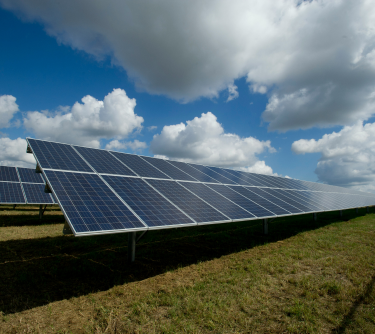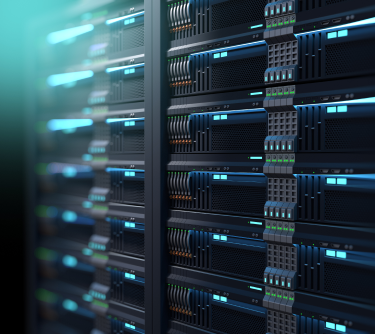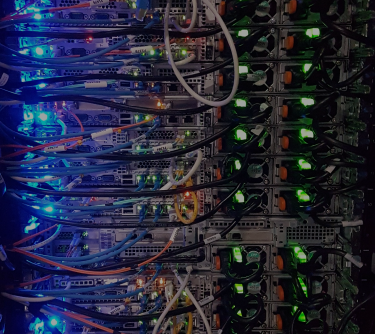Data Centers: Cornerstones of Digital Economies and Enablers of AI-Driven Growth
Data centers are integral to the development of robust digital economies and serve as foundational pillars for the socio-economic advancement of nations. As critical infrastructure, they facilitate the seamless exchange of information, underpinning various digital activities. Furthermore, data centers play a pivotal role in the proliferation of artificial intelligence, providing the computational power and storage capabilities necessary for AI innovation. Explore how these essential facilities are driving economic growth, fostering technological advancements, and creating opportunities in the digital era.


Conventional data centres are designed with
per rack as an average
AI generates far more data and requires
per rack as an average
About 20% of global data center capacity is already being used for AI and is expected to grow.
Data Centres are enabling the digital transformation and AI revolution trend
01
Data centers are the backbone of the digital economy, powering a very energy-intensive Artificial Intelligence (AI) and technology revolution. Running digital apps demands advanced hardware, such as specialised electronic circuits that accelerate graphics and image transferring and AI and machine learning (ML) workloads.
The impact of technology and data infrastructure extends beyond mere applications and day-to-day online interactions - it also profoundly influences economic development. In the current economic landscape, technology serves as a catalyst for international trade and business.
Although the absolute output of international trade is on the rise, the trade intensity, measured as the percentage of Gross Domestic Product (GDP), is decreasing.
Download ReportNotably, international flows of services are assuming a more significant role in global value chains, emerging as a new driver of globalization alongside digital shifts.
The ease facilitated by technological advancements and the digitization in trading services across borders has allowed service providers to access new markets and customers. Looking ahead, forthcoming technological disruptions such as AI and the Internet of Things are poised to further fuel the growth of trade in services.
Download ReportThe global generative AI market alone, with a market size at USD 67 billion today, is projected to grow to USD 1.3 trillion over the next 10 years.
This surge is driven by the increasing demand for AI-purposed hardware devices and infrastructure, and AI software spending. Moreover, rising demand for generative AI products could generate around $280 billion in additional software revenue. Major beneficiaries would include known names such as Amazon Web Services, Microsoft, Google, and Nvidia, as enterprises move their workloads to the public cloud.
Generative AI Market Growth, USD Billion
At the heart of this digital transformation, robust data centers play a pivotal role. They serve as the backbone of the digital economy, facilitating the seamless flow of data and services across borders. Data centers and data hubs, with their advanced infrastructure and capabilities, are uniquely positioned to meet this demand.
Just to understand the growth prospects, the global data center market size, measured in total revenue worth USD 324 Bn today, is projected to grow at a CAGR of 5.8%, reaching USD 436 Bn by 2028. When examining specific segments, the global colocation data center market is forecasted to experience even higher growth, with a 5-year Compound Annual Growth Rate (CAGR) of 11.3% from 2021 to 2026.
Download Reportof total data center storage capacity is being used for AI
Volume of data created, captured, copied, and consumed worldwide, (zettabytes)
Number of internet users worldwide (in billions)
To accommodate for the massive growth of data volume and internet usage, more than 900 hyperscale data centers are in operation today, and an additional few hundred are currently under construction.


The hyperscale market is anticipated to grow at an even faster rate
Of data expected to be generated in 2025.
About 20% of global data center capacity is already being used for AI and is expected to grow.
02
While comprising of a diverse hub ecosystem, DCs also act as the backbone of the new digital economy
A Regional Data Hub facilitates the flow of data across countries
Download Report
Major Internet Content Providers
Global tech giants (Google, Meta, Amazon, Netflix, etc.)… generate and manage a significant portion of the world’s digital content (e.g., Netflix is responsible for 15% of Global Internet Traffic).

Presence in local and regional Data Centers
These companies rely on data centers and hubs to store, process, and distribute this content to users across the region.

Connecting through a multitude of telecom operators
This exchange is enabled by telecom operators providing the necessary network infrastructure for data exchange, enabling high-speed connectivity and broad network coverage.

Over international and regional cables and through local & regional Internet Exchanges
Data hubs are connected to the global internet infrastructure through local and regional Internet Exchanges.
Data Hubs are formed by the confluence of an ecosystem of data centers that need to interact seamlessly as part of their service delivery with a diverse set of data center ecosystem stakeholders.
Data center infrastructure has a significant impact on economic development by creating jobs and driving entrepreneurship, both during construction and operational phases.
Download ReportIn the United States (US), for example, during the construction of a typical data center with a capital expenditure of USD 215.5 million, 1,688 local workers are employed and an average of USD 243.5 million in output is generated. In addition, the average data center produces USD 9.9 million in tax revenue for state and local governments. Every year after construction, that same data center directly supports 157 local jobs paying USD 7.8 million in wages, injecting USD 32.5 million into the local economy, and generating USD 1.1 million in revenue to state and local governments.
While being built, a typical data center produces $243.5 million in output in the US. Every year thereafter it generates $32.5 million for the local economy. With a capital expenditure of USD 215.5 million, 1,688 local workers are employed and an average of USD 243.5 million in output is generated
In another example, the data center and cloud industry has become an important part of the Dutch economy, accounting for around 25% of real GDP. The data center and cloud industry attracts around 20% of all foreign direct investment (FDI) in the country, making it the largest sector when it comes to FDI. With a growth rate of around 10% per year, more and more people have a job that is directly or indirectly related to this sector.
Dutch Internet economy has a value of €110 billion and accounts for 333,000 jobs, data center market accounts for 13,000 jobs in the country
These figures highlight the substantial economic benefits that data centers bring to local economies, not only through direct employment, but also through indirect effects on local businesses and the broader economy.
As such, data centers are not just a critical infrastructure for the digital economy, but also key drivers of economic growth and job creation.
While comprising of a diverse hub ecosystem, DCs also act as the backbone of the new digital economy
For example, Google has invested USD 17.5 billion in the construction of 12 North American data center campuses since 2006. Network infrastructure being developed by Google connects its data centers in the US to the entire global data ecosystem.
Throughout 2020, Google's operations in data centers, renewable energy, and capital investments collectively supported around 58,000 jobs, produced close to USD 4.0 billion in worker income, and contributed USD 6.4 billion to the GDP, thereby stimulating economic activity across the United States.
The 58,000 jobs include both direct employment, and jobs created indirectly through ripple effects as Google employees and suppliers circulate their earnings within the region. Although most of these jobs are based in the states housing the data centers, nearly 15,000 are based in other parts of the country.
This broad dispersion of jobs can largely be credited to the extensive network of individuals and businesses supplying Google with the necessary goods and services to facilitate data center operations, capital projects, and clean energy initiatives.
Employment opportunities facilitated by Google are spread out extensively, with a majority falling under sectors that are not typically linked with data center operations (see Figure 5).
In Europe, for every job supported by data center operations, three more jobs are supported through Google’s capital investments and clean energy commitments. In 2020, over 22,211 jobs in the region were supported by Google’s operations, clean energy commitments, and capital investment in the data center.
Download ReportData centers produce jobs in all three economic impact channels: direct, indirect (supply chain), and induced (spillover).
The broad spillover effects of data center operations and investments translate to economic activity for the region at large. The jobs supported by data center operations are widely distributed, and many are in industries not normally associated with data center operations. The impact of Google data center operations on jobs was spread across 11 sectors, led by information, communication, and telecom.
In fact, just over 50% of these jobs are in European countries that do not even host a Google data center. We can attribute this wide distribution of jobs to the capital investments made by Google for data center development, and the energy generation capacity needed to support Google’s clean energy commitments. These each require large amounts of physical and human capital that is sourced from throughout the continent.
Download ReportDistribution of Google’s data center-supported jobs by industry in the US
United States
Europe


Impact of Data Centers infrastructure on countries’ economy
03
Whiteshield has conducted a high-level assessment to forecast the direct economic impact of investments in data center infrastructure across a select group of countries. This group comprises the US, Indonesia, Turkiye, the Kingdom of Saudi Arabia (KSA), Ireland, Singapore, the United Arab Emirates (UAE), and Egypt. Collectively, these countries account for one-third of the global data center market, which is worth of USD 101 billion.
The analysis shows that, on average, these investments will contribute to an annual growth rate of 0.1-0.2% in the gross domestic product (GDP) of the selected countries. This signifies a substantial boost to their economies, given the pivotal role of data centers in today’s digital age.
Moreover, the forecast shows an increase of 0.03-0.11% in total employment each year in these countries as a result of the data center investments. For a country like Turkiye, for example, this means an additional 5,000 direct jobs will be created in one year. This underscores the significant role of the data center industry in job creation, contributing to economic stability and growth.
It’s important to note that these are high-level estimates and actual impacts may vary based on a range of factors.
GDP
Data center infrastructure investment significantly contributes to national economic growth by injecting capital into the economy. The establishment and operation of data centers create a direct positive impact on the GDP. This influence is not confined to the data center industry alone; it permeates various sectors through the multiplier effect, fostering a robust economic environment.
Employment and Skills
Investments in data center infrastructure serve as a pivotal driver of employment and skills development. The construction, operation, and maintenance of data centers necessitate a diverse skill set, generating job opportunities across a spectrum of professions. Furthermore, these investments catalyse skill enhancement initiatives, aligning the workforce with the evolving demands of the digital economy.
Entrepreneurship and Investment
The establishment of data centers fosters a thriving ecosystem for entrepreneurship and investment. The technological demands of data centers spur the emergence of innovative start-ups, creating a dynamic business environment. Simultaneously, these investments attract further capital, both domestically and internationally, solidifying the region’s position as a hub for technological advancement.
Cross-Sectoral Growth
Data Center investments drive cross-sectoral growth by acting as a catalyst for technological advancements. Industries such as telecommunications, cloud services, and software development experience heightened demand, driving innovation and collaboration. This interdependence creates a ripple effect, positively influencing the entire supply chain and bolstering overall economic development. Source: Whiteshield
Sustainability
Sustainability is a key facet of data center infrastructure investment. Through rigorous energy-efficient practices and environmentally conscious strategies, data centers can contribute to a greener and more sustainable future. The implementation of renewable energy sources, coupled with innovative cooling technologies, underscores a commitment to minimising the environmental footprint associated with data center operations.
Innovation
Investments in data center infrastructure position regions as hubs for technological innovation. By allocating resources to research and development initiatives, data center investments stimulate continuous advancements in technology. Collaborations between data centers, universities, and research institutions further amplify innovation, creating a fertile ground for cutting-edge breakthroughs and technological leadership.
increase in total employment each year as a result of the data center investments.
Data center investments can contribute between 0.1-0.2% to the real GDP
Estimated impact of data center infrastructure investment


04
The global data center market is experiencing rapid growth, driven by expanding data needs and increased investor interest due to the steady, cash flows and risk-adjusted yields.
As of 2022, the data center market reached a substantial size, totalling USD 313.6 billion, and it is expected to advance at an annual growth rate of 5.8% during 2022–2028, to reach USD 438.6 billion by 2028..
Currently, the US, China and Europe dominate the market. The US alone is responsible for 43% of global data center business, generating USD 92 billion in revenue. In terms of power consumption, the US holds a 40% market share at 17GW, set to grow by 9.4% annually until 2030. As of September 2023, there were a reported 5,375 data centers in the US (see Figure 7 and 9).
Download ReportNumber of data centers worldwide (by country, as of September 2023)
In 2021, FDI into data centers reached a peak of USD 47.6 billion, with Amazon’s subsidiary Amazon Web Services (AWS) making multi-billion-dollar investments in a new data center infrastructure region in New Zealand, and a new cloud computing hub in Canada — both of which were aimed at serving domestic markets. FDI into data centers maintained its momentum in 2022, with projects worth USD 44.8 billion announced globally.
Europe continues to lead in terms of FDI rankings, with a total USD 14.8 billion worth of investments. However, they have the slowest growth rate, compared to other regions.
The APAC market is the second largest region with USD 13.6 billion of FDI inflows. India has received the most foreign investment in data centers since 2019, with 145 FDI projects in cloud and data center infrastructure.
The fastest growing foreign direct investment hot spot is North America. Since 2019, the US has observed 69 FDI projects in cloud and data center infrastructure.
The Middle East region has shown significant progress in attracting foreign direct investment in the data center infrastructure market - the region has seen a massive, four-fold growth since 2017.
The FDI in data center is at peak with North America, Middle East and Africa seeing the highest spike
Global data center market, Revenues, USD Bn
Foreign direct investment into data centers* by world region


Data centers Investment Attractiveness Framework
05
The Whiteshield Data center Investment Attractiveness framework is designed to assess which countries are best positioned to attract data center investments across three pillars: supply, demand, and policy.
Supply
The supply pillar measures feasibility and cost-effectiveness of setting up a data center in a particular location. Factors such as the availability of skilled labor, reliable utilities, robust infrastructure, and suitable land can significantly impact the operational efficiency and profitability of a data center.
Demand
The demand pillar assesses the potential market for data center services. High demand indicates a thriving digital economy, which can lead to higher revenues for data center investors and operators. Factors such as market conditions, latency, and coverage can give insights into potential customer base, their needs, and how well these needs can be met.
Policy
Finally, the policy environment can significantly impact the ease of doing business and the risk associated with data center operations. Favourable policies, such as those promoting innovation and protecting data, can attract data center investment. On the other hand, stringent regulations or bureaucratic red tape can pose challenges. Thus, understanding the policy landscape is essential for assessing both the opportunities and risks associated with data center investment in a particular country.
Supply
Labor
Availability of skilled labor force
Utilities
Reliability of electricity supply, availability of renewable energy sources
Infrastructure
Cost of construction and availability of technical material
Land
Availability and cost of suitable land for data center construction
Demand
Market Size
Size of the local digital market, presence of large IT companies
Market Growth
Growth rate of the digital sector, projected growth of digital services
Latency
Average internet speed, latency to major internet hubs and regional eyeballs
Coverage
Number of internet users at the regional level, internet penetration rate
Policy
Business Regulation
Ease of doing business, level of bureaucratic red tape
Innovation Promotion
Government spending on R&D, number of patents filed in IT, presence of tech incubators and accelerators
Data Protection and Privacy
Existence of data protection laws, privacy laws, and their enforcement
Sectoral Incentives
Government incentives for data center investment, such as tax breaks, grants, or subsidised loans
Which is the best country to invest in for a data center?
Download Report

creation of more jobs due to strategic AI integration than those that will be lost by 2030
Countries with resilient digital infrastructure tend to benefit more from AI impact on economy and jobs
06
The benefits of investing in AI infrastructure will outweigh the negative aspects of AI and its impact on jobs
Countries with resilient digital infrastructure are well-positioned to leverage the transformative impact of the AI revolution, fostering robust labor markets that generate benefits rather than succumb to job displacement. Whiteshield analysis underscores a substantial correlation between a country’s labor market preparedness for AI and its proficiency in data infrastructure.
The case of the US serves as a compelling illustration, where strategic AI integration is anticipated to result in the creation of 4.8 times more jobs than those that will be potentially lost by 2030. This emphasises the critical role played by advanced digital and data frameworks in not only mitigating employment challenges, but also in propelling economic growth amidst the unfolding AI revolution.
Download ReportCorrelation between labor market preparedness and digital infrastructure
Projected impact of AI on jobs, US case, million jobs, 2023-2030


The global data security market size in 2023
The global data security market size is projected to reach by 2030
This indicates the critical need for secure data storage and management solutions.
Impact of Data Centers infrastructure on countries' economy
07
Understanding the spectrum of risks associated with AI is crucial as its applications become more pervasive in our daily lives. To navigate this complex landscape, one approach to categorise these risks is provided by the National Institute of Standards and Technology (NIST), which divides them into three principal areas: Harm to People, Harm to Organizations, and Harm to Ecosystems. This categorisation helps in identifying, assessing, and mitigating the potentially adverse effects of AI technologies.
Harm to people
Individual
Harm to a person’s civil liberties, rights, physical or psychological safety, or economic opportunity
Group/Community
Harm to a group such as discrimination against a population sub-group
Societal
Harm to democratic participation or educational access
Examples
- Deepfakes/disinformation
- Misinformation
- Discrimination
- Data Breaches
Harm to Organizations
Operational
Harm to an organization’s operations
Security/FInancial
Harm to an organization from security breaches or monetary loss
Reputational
Harm to an organization’s reputation
Examples
- Cyber Attacks
- IP Rights Infrigment
Harm to Ecosystem
Interconnectivity
Harm to interconnected and interdependent elements and resources
Systemic
Harm to the global financial system, supply chain, or interrelated systems
Environmental
Harm to natural resources, the environment, and planet
Examples
- Environmental Impact of Compute Power
- Attacks on Critical Infrastructure
In a rapidly evolving digital landscape, the role of data centers in national data security and data sovereignty has become increasingly significant. The global cyber security market size was valued at USD 172.3 billion (data security market – 28.8 billion) in 2023, and is projected to reach USD 424.9 billion (data security market – 68.29 billion) in 2030, exhibiting a 13.8% CAGR. This indicates the critical need for secure data storage and management solutions.
Global Data Security Trends
The global data security landscape is witnessing unprecedented challenges and opportunities. As cyber threats become more sophisticated, the importance of secure data centers has never been more critical. Advanced security technologies such as encryption, intrusion detection systems (IDS), and physical security measures are now standard in data centers worldwide.
Data Sovereignty and Compliance
Countries are increasingly enacting data protection regulations such as the European Union’s General Data Protection Regulation (GDPR) and the California Consumer Privacy Act (CCPA) in the United States. Data centers play a pivotal role in ensuring that data handling practices comply with these regulations, thereby enhancing data sovereignty. They are designed to provide a secure environment that meets specific legal and regulatory requirements.
Innovations in Data center Security
Innovations in data center technology, such as the use of the AI and ML for security monitoring, are setting new standards for data protection. These technologies enable real-time threat detection and automated responses, enhancing the security posture of data centers and, by extension, the national data they protect.
Selected cases of data protection approaches
With its strong focus on data privacy and security, Germany hosts numerous data centers that adhere to rigorous national and European data protection standards. These facilities are vital for Germany’s Industrie 4.0, a strategic initiative to digitalize the manufacturing sector, ensuring secure data flows and industrial data sovereignty.
Positioned as a key data distribution hub, the Netherlands’ data centers serve not only local companies but also the broader European market. The government’s Spatial Strategy Data centers 2030 is committed to sustainability and the strategic growth of these centers, which are pivotal to the country’s tech employment and digital economy.
Established the world’s first ‘Data Embassy’ in Luxembourg to safeguard government-critical data outside its territorial borders, ensuring digital continuity and security, even in crisis situations.









